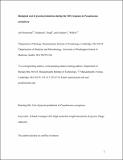| dc.contributor.author | Penterman, Jon | |
| dc.contributor.author | Singh, Pradeep K. | |
| dc.contributor.author | Walker, Graham C. | |
| dc.date.accessioned | 2015-09-03T12:40:52Z | |
| dc.date.available | 2015-09-03T12:40:52Z | |
| dc.date.issued | 2014-07 | |
| dc.date.submitted | 2014-05 | |
| dc.identifier.issn | 0021-9193 | |
| dc.identifier.issn | 1098-5530 | |
| dc.identifier.uri | http://hdl.handle.net/1721.1/98343 | |
| dc.description.abstract | LexA and two structurally related regulators, PrtR and PA0906, coordinate the Pseudomonas aeruginosa SOS response. RecA-mediated autocleavage of LexA induces the expression of a protective set of genes that increase DNA damage repair and tolerance. In contrast, RecA-mediated autocleavage of PrtR induces antimicrobial pyocin production and a program that lyses cells to release the newly synthesized pyocin. Recently, PrtR-regulated genes were shown to sensitize P. aeruginosa to quinolones, antibiotics that elicit a strong SOS response. Here, we investigated the mechanisms by which PrtR-regulated genes determine antimicrobial resistance and genotoxic stress survival. We found that induction of PrtR-regulated genes lowers resistance to clinically important antibiotics and impairs the survival of bacteria exposed to one of several genotoxic agents. Two distinct mechanisms mediated these effects. Cell lysis genes that are induced following PrtR autocleavage reduced resistance to bactericidal levels of ciprofloxacin, and production of extracellular R2 pyocin was lethal to cells that initially survived UV light treatment. Although typically resistant to R2 pyocin, P. aeruginosa becomes transiently sensitive to R2 pyocin following UV light treatment, likely because of the strong downregulation of lipopolysaccharide synthesis genes that are required for resistance to R2 pyocin. Our results demonstrate that pyocin production during the P. aeruginosa SOS response carries both expected and unexpected costs. | en_US |
| dc.description.sponsorship | National Institutes of Health (U.S.) (GM31010) | en_US |
| dc.description.sponsorship | National Institutes of Health (U.S.) (National Research Service Award) | en_US |
| dc.language.iso | en_US | |
| dc.publisher | American Society for Microbiology | en_US |
| dc.relation.isversionof | http://dx.doi.org/10.1128/JB.01889-14 | en_US |
| dc.rights | Creative Commons Attribution-Noncommercial-Share Alike | en_US |
| dc.rights.uri | http://creativecommons.org/licenses/by-nc-sa/4.0/ | en_US |
| dc.source | Walker | en_US |
| dc.title | Biological Cost of Pyocin Production during the SOS Response in Pseudomonas aeruginosa | en_US |
| dc.type | Article | en_US |
| dc.identifier.citation | Penterman, J., P. K. Singh, and G. C. Walker. “Biological Cost of Pyocin Production During the SOS Response in Pseudomonas aeruginosa.” Journal of Bacteriology 196, no. 18 (July 14, 2014): 3351–3359. | en_US |
| dc.contributor.department | Massachusetts Institute of Technology. Department of Biology | en_US |
| dc.contributor.approver | Walker. Graham C. | en_US |
| dc.contributor.mitauthor | Penterman, Jon | en_US |
| dc.contributor.mitauthor | Walker, Graham C. | en_US |
| dc.relation.journal | Journal of Bacteriology | en_US |
| dc.eprint.version | Author's final manuscript | en_US |
| dc.type.uri | http://purl.org/eprint/type/JournalArticle | en_US |
| eprint.status | http://purl.org/eprint/status/PeerReviewed | en_US |
| dspace.orderedauthors | Penterman, J.; Singh, P. K.; Walker, G. C. | en_US |
| dc.identifier.orcid | https://orcid.org/0000-0001-7243-8261 | |
| mit.license | OPEN_ACCESS_POLICY | en_US |
| mit.metadata.status | Complete | |
